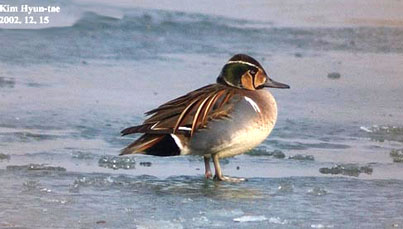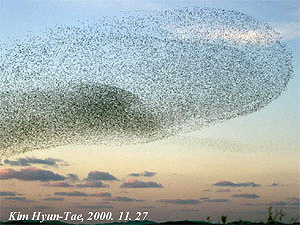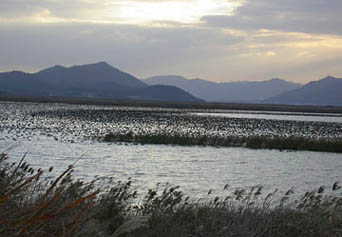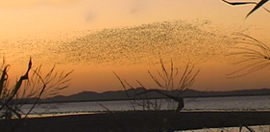
The Baikal Teal Anas formosa is one of South Korea's most attractive (the specific name "formosa" means "beautifully formed") and charismatic winter visitors, arriving en masse at the Seosan lakes in mid-October, and spreading further south as temperatures drop and wintering areas freeze. The male is one of the most distinctive ducks in the northern hemisphere, and interestingly this "distinctiveness" appears to extend to the genetic level: a 1999 DNA sequence study of Anas dabbling ducks concluded that the Baikal Teal is not closely related to any other extant duck species, and is the sole representative of one of the four major clades of the sub-group of Anatanae (Johnson and Sorenson, Auk 116).
In more detail, the male's head in breeding, or alternate, plumage has a striking combination of yellow, green, and black-and-white colours. Most eye-catching is a white supercilium stretching to the nape, and a curving black line dropping like an inky tear from the eye to the throat.
The upperparts are generally dull brown, with long rufous and white fringed scapulars. Underparts at rest show a strongly pinkish breast, white vertical breast stripe and grey flanks. The bill dark grey; legs and feet grey to yellowish; iris brown. Female Baikal Teals are similar to Eurasian Teal, but are more contrastingly grey-faced and warm breasted with greater contrast in face pattern. The face has a pale loral spot encircled with a dark border, and dark eyestripe; often shows dark and pale mark across lower cheek. Bill, feet and eye as male.
There are two body moults annually. The breeding plumage is worn from Oct-July, but some birds are not fully coloured until the end of the year (Delacour 1954-64). Males in eclipse, or basic, plumage resemble the females, but are rather richer rufous, and often shows dark tear-drop of breeding plumage (for more details see Palmer 1976).

The immature resembles the female, but the facial pattern is less defined, and the bird has browner rather than rufous tones (Madge and Burn 1988). Males perhaps show paler bills towards base.
Effectively confined to northeast Asia (with vagrants occurring south to Mongolia and India, east to North America (chiefly Alaska but south to California), and very rarely west to Europe), the type specimen, as the name suggests, was taken at Lake Baikal, and the species breeds across eastern Siberia, from Yenisey Valley eastwards to Cape Shmidt on Chukotka peninsula, western Anadyr' basin, northern Kamchatka and Sea of Okhotsk coast. Over much of its huge range the Baikal Teal was always thought to be common but somewhat localised with main concentrations centred on the basins of major river systems (Madge and Burn 1988).
Considered in the first half of the twentieth century to be the commonest duck regionally, in the mid part of the century this beautiful duck began a rapid decline. In China in the early 20th century, the species was a locally abundant visitor to the Yangtze basin (see e.g., Guan Guanxun et al. 1963) and Fujian (see Cheng Tso-hsin 1941) and presumably elsewhere, but in the past 2 decades no reports have been made of very large concentrations (incidentally the species has never been recorded at the massive Poyang Lake (TWSG News Oct 2003)).

This pattern was repeated across the birds' entire range as they suffered catastrophic drops in numbers due to increased pesticide use in staging areas and most especially as a result of massive over-hunting , particularly in Japan where there were fewer than 10 000 by 1980, a count of just 2756 in 1987, and only 1912 in 1988 (Brazil 1991). This is particularly notable when one oft-repeated account states that 3 Japanese hunters in 1947 (using throw-nets) caught 50 000 Baikals on one pond in only 20 days...
By the early 1980s, when several thousand were found wintering in the southeast of Korea, it was feared that possibly as few as 20 000 remained globally. Authors began to talk of the population becoming so low that the species might never recover, but in a complex and incidental conservation scenario recent years have seen the population rebound spectacularly, as Baikal Teals have started to exploit good feeding and safe roosting opportunities in the newly-created rice-fields and reclamation lakes now lining the South Korean west coast - particularly at Seosan, but also Haenam (and in smaller numbers at Joonam in the south-east).

Geocheonnam. Photo © NM
Apparently increasing by several percent each year, they are being increasingly reported by Siberian hunters in their old haunts and have - remarkably - now probably already become South Korea's commonest duck. A report in the October 2003 bulletin of the Threatened Waterbird Specialist Group sugggests that the Baikal Teal should probably no longer be listed by IUCN as globally threatened, nor included in the Russian Red Data Book, though it does caution that the huge increase in reported numbers may be linked to increased observer coverage and/or redistribution of Japanese wintering birds as well as genuine population growth.
How accurate is this percieved growth? Breeding sites appear to be used one year and not the next, and migration takes place at night (and at high altitude) making a true census very difficult. The flocks Baikal Teals form in South Korea are so huge and densely packed (and mobile) that it is extremely hard to census well even here where the birds are present for long periods, but it is generally believed that a staggering 350 000 - 400 000 were present nationwide between late October and March 2001/2002: in 2003 flocks at Haenam had built to similar levels by mid-November.

In most winters the Baikals begin arriving in South Korea at the end of September, and, for example, by the second week of October 2002 about 30,000 were back at Seosan. Here the Baikals remain in densely packed flocks in the middle of the lake during the day, flighting out to feed at dusk in rice stubble - creating one of Asia's most memorable birding events as thousands upon thousands of duck swirl and dance across the evening sky to a backdrop of the calls of thousands of Tundra Bean Geese and Greater White-fronts. (The Baikals themselves are rather quiet in winter, though roosting flocks emit a low rumbling noise, reminiscent of distant busy roadway: however these vocalisations are barely audible more than 500 m away even in still weather.)
The following table details the numbers of Baikal Teal recorded at the Seosan Lake complex in winter 2002 (with thanks to Kim Hyun-tae):
| Lake | Date | Number | Lake | Date | Number |
| Seosan A | 2002.09.01 | 3 | Seosan B | 2002.10.31 | 100,000+ |
| Seosan A | 2002.09.15 | 500+ | Seosan B | 2002.11.01 | 100,000+ |
| Seosan A | 2002.09.19 | 2,500 | Seosan A | 2002.11.03 | 130,000+? |
| Seosan A | 2002.09.21 | 4,800 | Seosan A | 2002.11.05 | 300,000+? |
| Seosan A | 2002.10.03 | 10,000 | Seosan A | 2002.11.08 | 100,000+ |
| Seosan A | 2002.10.15 | 30,000 | Seosan A | 2002.11.10 | 100,000+ |
| Seosan A | 2002.10.20 | 50,000 | Seosan B | 2002.11.12 | 100,000+ |
| Seosan B | 2002.10.27 | 150,000 | Seosan A | 2002.11.13 | 100,000+ |
| Seosan B | 2002.10.30 | 100,000+ | Seosan A | 2002.11.15 | 50,000+ |

Counts in November 2003 included the following:
| November 06, Seosan A | 200,000 |
| November 07, Seosan A | 150,000 |
| November 12, Seosan A | 270,000+ |
| November 13, Seosan A | 250,000 |
| November 14, Seosan A | 60-70,000 |
| November 15, Yeongnam Lake, Mokpo | ca 60,000 |
| November 16, Geocheonnam Lake, Haenam | 200,000+ |
| November 16, Geum River, | ca 5000+ |
| November 17, Geocheonnam Lake, Haenam | ca 400,000 |
| November 18, Geocheonnam Lake, Haenam | ca 350,000 |
| November 19, Geocheonnam Lake, Haenam | ca 300,000+ |
| November 20, Geocheonnam Lake, Haenam | ca 350,000+ |
(For more details on the BBC's visit, go to BBC at Seosan.)
References:
- References:
- Madge and Burn (1988). Waterfowl of the World.
- Moores N. and Kyoung-Won K (2000). Baikal Teal in South Korea. TWSG News .12:14.
- TWSG News.TWSG Bulletin14, October 2003. Ed. Dr Baz Hughes
The "Threatened Waterfowl Specialist Group"(TWSG) is co-ordinated from the Wildfowl and Wetlands Trust at Slimbridge, UK, and is part of the specialist group network of Wetlands International (formerly IWRB), and the IUCN Species Survival Commision.
The group and listserver is chaired by Dr Baz Hughes. For more info go to www.wwt.org.uk/threatsp/twsg
.


